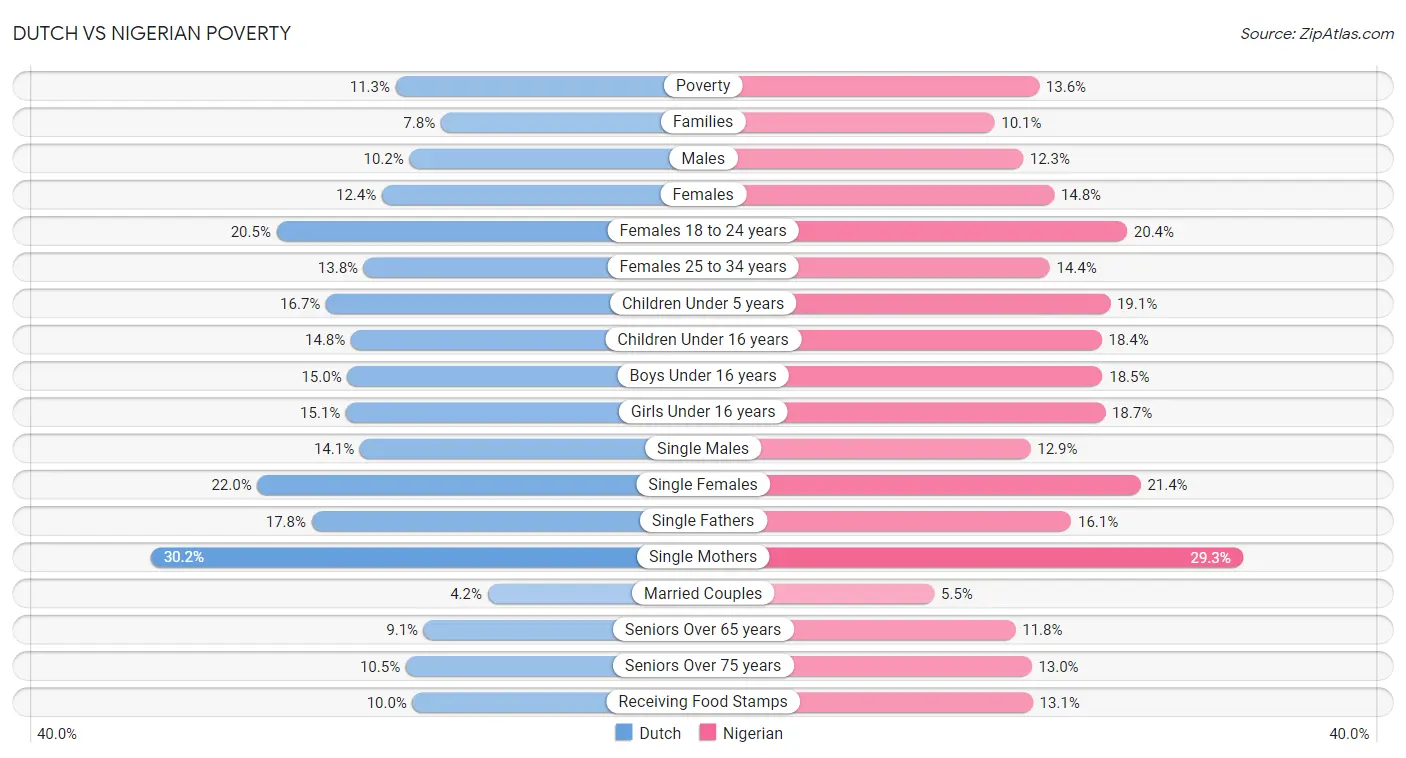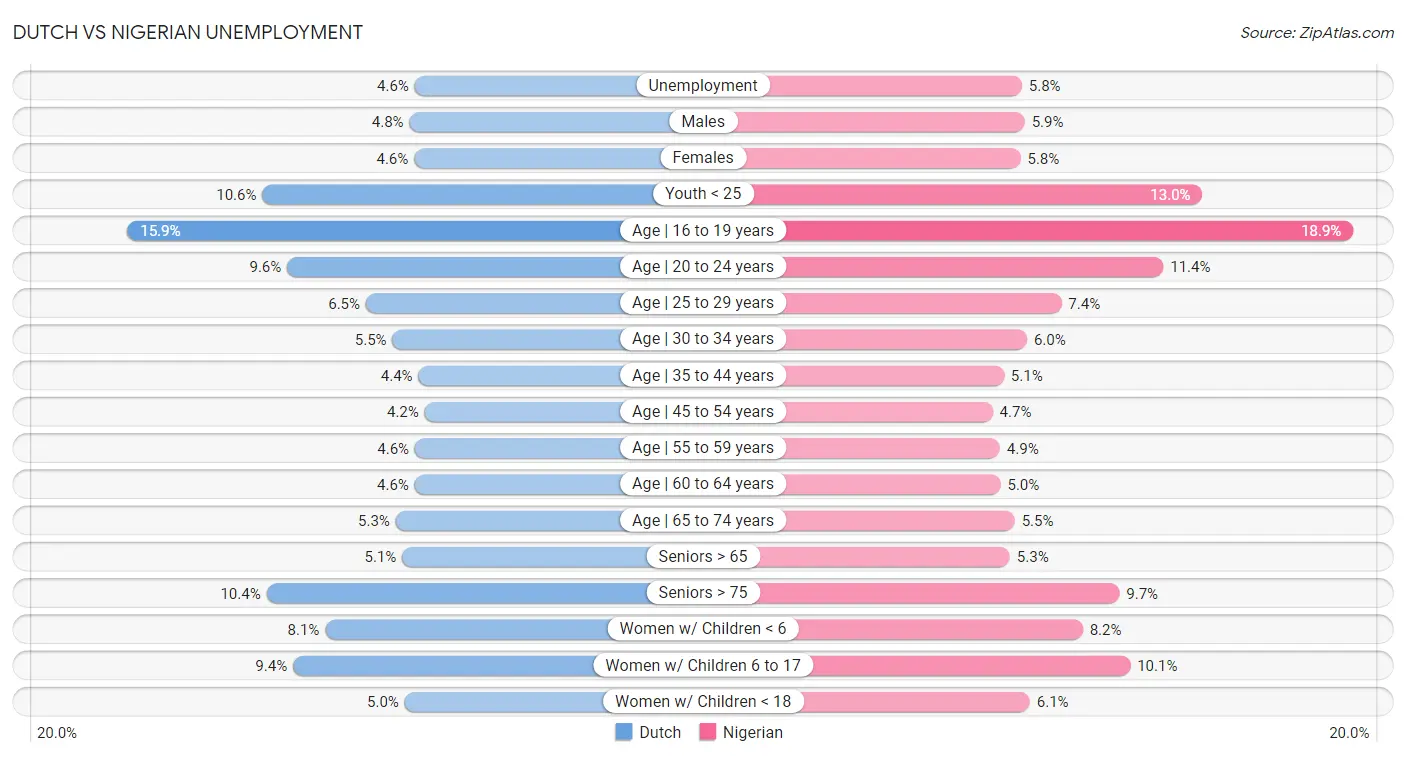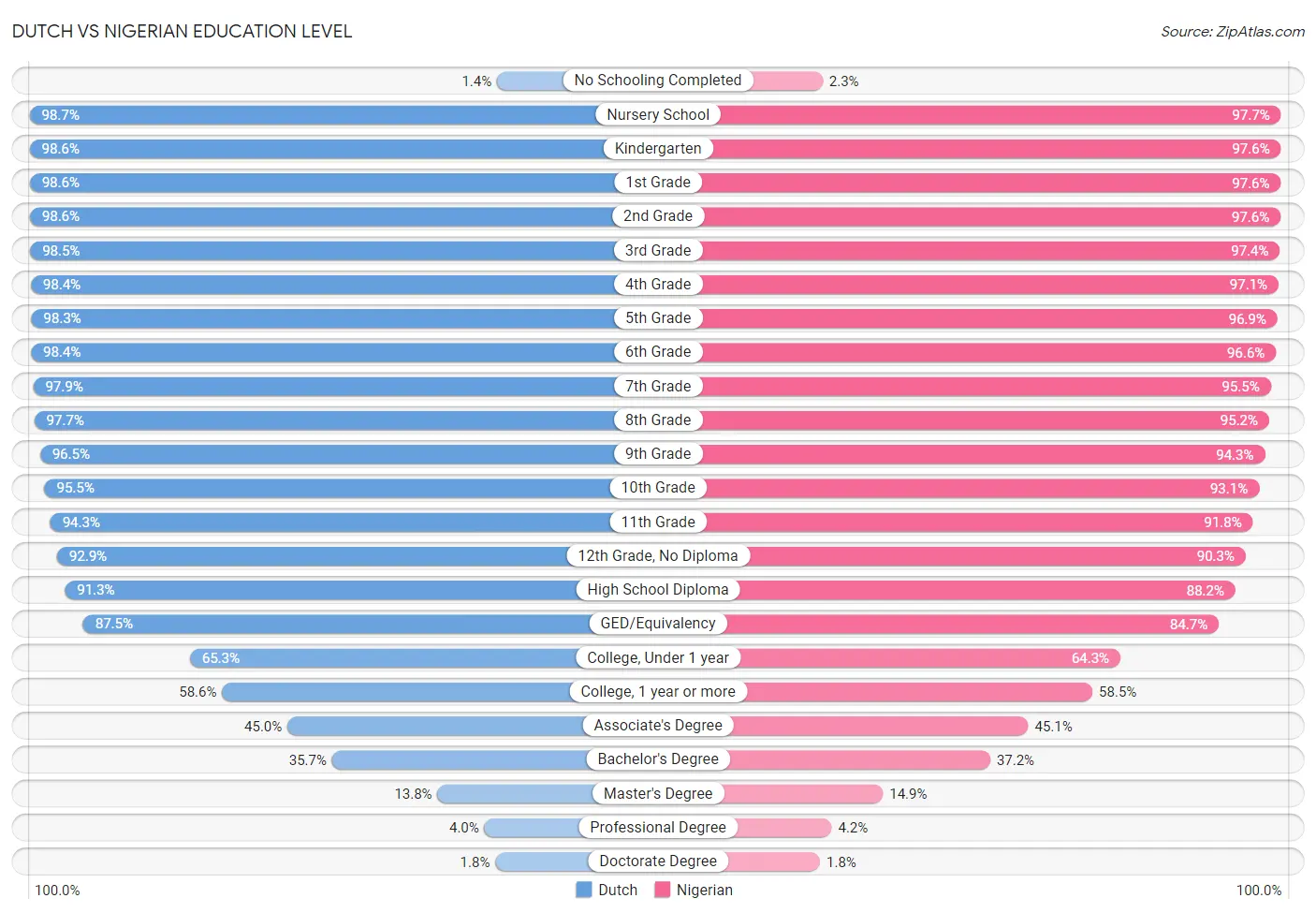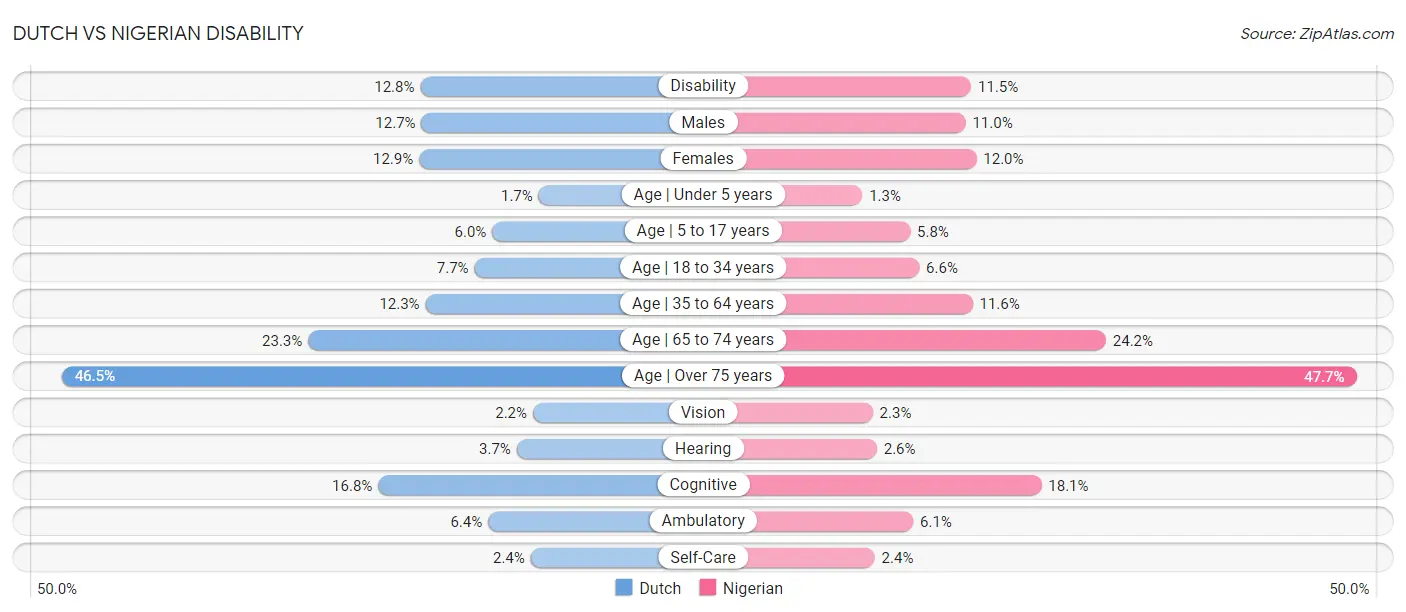Dutch vs Nigerian Community Comparison
COMPARE
Dutch
Nigerian
Social Comparison
Social Comparison
Dutch
Nigerians
6,444
SOCIAL INDEX
61.9/ 100
SOCIAL RATING
155th/ 347
SOCIAL RANK
1,996
SOCIAL INDEX
17.5/ 100
SOCIAL RATING
277th/ 347
SOCIAL RANK
Nigerian Integration in Dutch Communities
The statistical analysis conducted on geographies consisting of 326,301,887 people shows a poor negative correlation between the proportion of Nigerians within Dutch communities in the United States with a correlation coefficient (R) of -0.136. On average, for every 1% (one percent) increase in Dutch within a typical geography, there is a decrease of 0.002% in Nigerians. To illustrate, in a geography comprising of 100,000 individuals, a rise of 1,000 Dutch corresponds to a decrease of 2.4 Nigerians.

Dutch vs Nigerian Income
When considering income, the most significant differences between Dutch and Nigerian communities in the United States are seen in wage/income gap (29.6% compared to 23.0%, a difference of 29.0%), median female earnings ($37,339 compared to $39,641, a difference of 6.2%), and householder income ages 25 - 44 years ($93,081 compared to $87,730, a difference of 6.1%). Conversely, both communities are more comparable in terms of median earnings ($45,370 compared to $45,532, a difference of 0.36%), householder income over 65 years ($59,539 compared to $58,992, a difference of 0.93%), and median household income ($82,971 compared to $81,725, a difference of 1.5%).

| Income Metric | Dutch | Nigerian |
| Per Capita Income | Fair $42,605 | Tragic $41,026 |
| Median Family Income | Fair $101,192 | Tragic $97,522 |
| Median Household Income | Fair $82,971 | Poor $81,725 |
| Median Earnings | Poor $45,370 | Fair $45,532 |
| Median Male Earnings | Average $54,410 | Tragic $52,039 |
| Median Female Earnings | Tragic $37,339 | Average $39,641 |
| Householder Age | Under 25 years | Tragic $51,265 | Tragic $49,416 |
| Householder Age | 25 - 44 years | Fair $93,081 | Tragic $87,730 |
| Householder Age | 45 - 64 years | Average $99,650 | Tragic $95,492 |
| Householder Age | Over 65 years | Poor $59,539 | Poor $58,992 |
| Wage/Income Gap | Tragic 29.6% | Exceptional 23.0% |
Dutch vs Nigerian Poverty
When considering poverty, the most significant differences between Dutch and Nigerian communities in the United States are seen in receiving food stamps (10.0% compared to 13.1%, a difference of 31.0%), married-couple family poverty (4.2% compared to 5.5%, a difference of 30.8%), and family poverty (7.8% compared to 10.1%, a difference of 29.8%). Conversely, both communities are more comparable in terms of female poverty among 18-24 year olds (20.5% compared to 20.4%, a difference of 0.58%), single female poverty (22.0% compared to 21.4%, a difference of 2.6%), and single mother poverty (30.2% compared to 29.3%, a difference of 3.1%).

| Poverty Metric | Dutch | Nigerian |
| Poverty | Exceptional 11.3% | Tragic 13.6% |
| Families | Exceptional 7.8% | Tragic 10.1% |
| Males | Exceptional 10.2% | Tragic 12.3% |
| Females | Exceptional 12.4% | Tragic 14.8% |
| Females 18 to 24 years | Poor 20.5% | Fair 20.4% |
| Females 25 to 34 years | Fair 13.8% | Tragic 14.4% |
| Children Under 5 years | Good 16.7% | Tragic 19.1% |
| Children Under 16 years | Exceptional 14.8% | Tragic 18.4% |
| Boys Under 16 years | Exceptional 15.0% | Tragic 18.5% |
| Girls Under 16 years | Exceptional 15.1% | Tragic 18.7% |
| Single Males | Tragic 14.1% | Fair 12.9% |
| Single Females | Tragic 22.0% | Fair 21.4% |
| Single Fathers | Tragic 17.8% | Good 16.1% |
| Single Mothers | Tragic 30.2% | Fair 29.3% |
| Married Couples | Exceptional 4.2% | Poor 5.5% |
| Seniors Over 65 years | Exceptional 9.1% | Tragic 11.8% |
| Seniors Over 75 years | Exceptional 10.5% | Tragic 13.0% |
| Receiving Food Stamps | Exceptional 10.0% | Tragic 13.1% |
Dutch vs Nigerian Unemployment
When considering unemployment, the most significant differences between Dutch and Nigerian communities in the United States are seen in unemployment (4.6% compared to 5.8%, a difference of 27.2%), female unemployment (4.6% compared to 5.8%, a difference of 25.5%), and male unemployment (4.8% compared to 5.9%, a difference of 24.0%). Conversely, both communities are more comparable in terms of unemployment among women with children under 6 years (8.1% compared to 8.2%, a difference of 1.3%), unemployment among ages 65 to 74 years (5.3% compared to 5.5%, a difference of 3.9%), and unemployment among seniors over 65 years (5.1% compared to 5.3%, a difference of 5.4%).

| Unemployment Metric | Dutch | Nigerian |
| Unemployment | Exceptional 4.6% | Tragic 5.8% |
| Males | Exceptional 4.8% | Tragic 5.9% |
| Females | Exceptional 4.6% | Tragic 5.8% |
| Youth < 25 | Exceptional 10.6% | Tragic 13.0% |
| Age | 16 to 19 years | Exceptional 15.9% | Tragic 18.9% |
| Age | 20 to 24 years | Exceptional 9.6% | Tragic 11.4% |
| Age | 25 to 29 years | Excellent 6.5% | Tragic 7.4% |
| Age | 30 to 34 years | Average 5.5% | Tragic 6.0% |
| Age | 35 to 44 years | Exceptional 4.4% | Tragic 5.1% |
| Age | 45 to 54 years | Exceptional 4.2% | Tragic 4.7% |
| Age | 55 to 59 years | Exceptional 4.6% | Tragic 4.9% |
| Age | 60 to 64 years | Exceptional 4.6% | Tragic 5.0% |
| Age | 65 to 74 years | Good 5.3% | Tragic 5.5% |
| Seniors > 65 | Excellent 5.1% | Tragic 5.3% |
| Seniors > 75 | Tragic 10.4% | Tragic 9.7% |
| Women w/ Children < 6 | Tragic 8.1% | Tragic 8.2% |
| Women w/ Children 6 to 17 | Tragic 9.4% | Tragic 10.1% |
| Women w/ Children < 18 | Exceptional 5.0% | Tragic 6.1% |
Dutch vs Nigerian Labor Participation
When considering labor participation, the most significant differences between Dutch and Nigerian communities in the United States are seen in in labor force | age 16-19 (43.8% compared to 36.1%, a difference of 21.6%), in labor force | age 20-24 (78.4% compared to 74.7%, a difference of 4.9%), and in labor force | age > 16 (64.2% compared to 66.6%, a difference of 3.8%). Conversely, both communities are more comparable in terms of in labor force | age 30-34 (84.5% compared to 84.5%, a difference of 0.080%), in labor force | age 35-44 (84.3% compared to 84.4%, a difference of 0.16%), and in labor force | age 45-54 (82.8% compared to 82.7%, a difference of 0.19%).

| Labor Participation Metric | Dutch | Nigerian |
| In Labor Force | Age > 16 | Tragic 64.2% | Exceptional 66.6% |
| In Labor Force | Age 20-64 | Fair 79.3% | Good 79.7% |
| In Labor Force | Age 16-19 | Exceptional 43.8% | Fair 36.1% |
| In Labor Force | Age 20-24 | Exceptional 78.4% | Fair 74.7% |
| In Labor Force | Age 25-29 | Excellent 84.9% | Tragic 84.3% |
| In Labor Force | Age 30-34 | Fair 84.5% | Fair 84.5% |
| In Labor Force | Age 35-44 | Fair 84.3% | Average 84.4% |
| In Labor Force | Age 45-54 | Good 82.8% | Average 82.7% |
Dutch vs Nigerian Family Structure
When considering family structure, the most significant differences between Dutch and Nigerian communities in the United States are seen in single mother households (5.8% compared to 7.7%, a difference of 32.2%), married-couple households (49.5% compared to 43.2%, a difference of 14.6%), and currently married (49.6% compared to 43.4%, a difference of 14.2%). Conversely, both communities are more comparable in terms of family households (64.9% compared to 63.9%, a difference of 1.7%), divorced or separated (12.4% compared to 12.1%, a difference of 2.2%), and single father households (2.4% compared to 2.4%, a difference of 2.6%).

| Family Structure Metric | Dutch | Nigerian |
| Family Households | Exceptional 64.9% | Poor 63.9% |
| Family Households with Children | Fair 27.4% | Exceptional 28.4% |
| Married-couple Households | Exceptional 49.5% | Tragic 43.2% |
| Average Family Size | Tragic 3.11 | Exceptional 3.29 |
| Single Father Households | Poor 2.4% | Average 2.4% |
| Single Mother Households | Exceptional 5.8% | Tragic 7.7% |
| Currently Married | Exceptional 49.6% | Tragic 43.4% |
| Divorced or Separated | Tragic 12.4% | Fair 12.1% |
| Births to Unmarried Women | Average 31.5% | Tragic 35.3% |
Dutch vs Nigerian Vehicle Availability
When considering vehicle availability, the most significant differences between Dutch and Nigerian communities in the United States are seen in no vehicles in household (6.8% compared to 12.1%, a difference of 76.2%), 4 or more vehicles in household (7.7% compared to 6.0%, a difference of 27.4%), and 3 or more vehicles in household (22.9% compared to 18.6%, a difference of 23.3%). Conversely, both communities are more comparable in terms of 1 or more vehicles in household (93.3% compared to 88.0%, a difference of 6.0%), 2 or more vehicles in household (61.6% compared to 52.8%, a difference of 16.8%), and 3 or more vehicles in household (22.9% compared to 18.6%, a difference of 23.3%).

| Vehicle Availability Metric | Dutch | Nigerian |
| No Vehicles Available | Exceptional 6.8% | Tragic 12.1% |
| 1+ Vehicles Available | Exceptional 93.3% | Tragic 88.0% |
| 2+ Vehicles Available | Exceptional 61.6% | Tragic 52.8% |
| 3+ Vehicles Available | Exceptional 22.9% | Tragic 18.6% |
| 4+ Vehicles Available | Exceptional 7.7% | Poor 6.0% |
Dutch vs Nigerian Education Level
When considering education level, the most significant differences between Dutch and Nigerian communities in the United States are seen in no schooling completed (1.4% compared to 2.3%, a difference of 64.6%), master's degree (13.8% compared to 14.9%, a difference of 7.9%), and professional degree (4.0% compared to 4.2%, a difference of 4.8%). Conversely, both communities are more comparable in terms of associate's degree (45.0% compared to 45.1%, a difference of 0.20%), college, 1 year or more (58.6% compared to 58.5%, a difference of 0.23%), and nursery school (98.7% compared to 97.7%, a difference of 1.0%).

| Education Level Metric | Dutch | Nigerian |
| No Schooling Completed | Exceptional 1.4% | Tragic 2.3% |
| Nursery School | Exceptional 98.7% | Tragic 97.7% |
| Kindergarten | Exceptional 98.6% | Tragic 97.6% |
| 1st Grade | Exceptional 98.6% | Tragic 97.6% |
| 2nd Grade | Exceptional 98.6% | Tragic 97.6% |
| 3rd Grade | Exceptional 98.5% | Tragic 97.4% |
| 4th Grade | Exceptional 98.4% | Tragic 97.1% |
| 5th Grade | Exceptional 98.3% | Tragic 96.9% |
| 6th Grade | Exceptional 98.4% | Tragic 96.6% |
| 7th Grade | Exceptional 97.9% | Tragic 95.5% |
| 8th Grade | Exceptional 97.7% | Tragic 95.2% |
| 9th Grade | Exceptional 96.5% | Tragic 94.3% |
| 10th Grade | Exceptional 95.5% | Tragic 93.1% |
| 11th Grade | Exceptional 94.3% | Tragic 91.8% |
| 12th Grade, No Diploma | Exceptional 92.9% | Tragic 90.3% |
| High School Diploma | Exceptional 91.3% | Tragic 88.2% |
| GED/Equivalency | Exceptional 87.5% | Tragic 84.7% |
| College, Under 1 year | Average 65.3% | Poor 64.3% |
| College, 1 year or more | Fair 58.6% | Fair 58.5% |
| Associate's Degree | Poor 45.0% | Poor 45.1% |
| Bachelor's Degree | Tragic 35.7% | Fair 37.2% |
| Master's Degree | Tragic 13.8% | Average 14.9% |
| Professional Degree | Tragic 4.0% | Fair 4.2% |
| Doctorate Degree | Fair 1.8% | Fair 1.8% |
Dutch vs Nigerian Disability
When considering disability, the most significant differences between Dutch and Nigerian communities in the United States are seen in hearing disability (3.7% compared to 2.6%, a difference of 41.6%), disability age under 5 (1.7% compared to 1.3%, a difference of 31.7%), and disability age 18 to 34 (7.7% compared to 6.6%, a difference of 16.4%). Conversely, both communities are more comparable in terms of self-care disability (2.4% compared to 2.4%, a difference of 0.43%), vision disability (2.2% compared to 2.3%, a difference of 1.5%), and disability age over 75 (46.5% compared to 47.7%, a difference of 2.6%).

| Disability Metric | Dutch | Nigerian |
| Disability | Tragic 12.8% | Excellent 11.5% |
| Males | Tragic 12.7% | Excellent 11.0% |
| Females | Tragic 12.9% | Excellent 12.0% |
| Age | Under 5 years | Tragic 1.7% | Fair 1.3% |
| Age | 5 to 17 years | Tragic 6.0% | Tragic 5.8% |
| Age | 18 to 34 years | Tragic 7.7% | Average 6.6% |
| Age | 35 to 64 years | Tragic 12.3% | Poor 11.6% |
| Age | 65 to 74 years | Average 23.3% | Tragic 24.2% |
| Age | Over 75 years | Exceptional 46.5% | Poor 47.7% |
| Vision | Poor 2.2% | Tragic 2.3% |
| Hearing | Tragic 3.7% | Exceptional 2.6% |
| Cognitive | Exceptional 16.8% | Tragic 18.1% |
| Ambulatory | Tragic 6.4% | Good 6.1% |
| Self-Care | Good 2.4% | Good 2.4% |